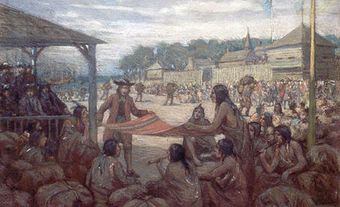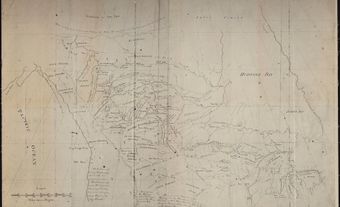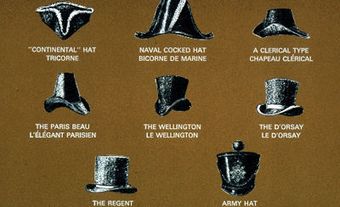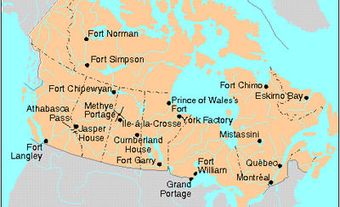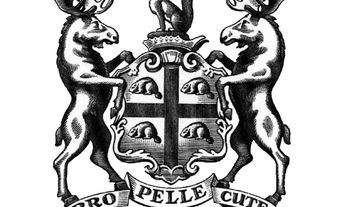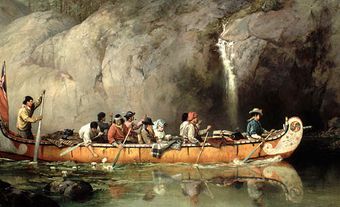The Hudson’s Bay Company (HBC), chartered 2 May 1670, is the oldest incorporated joint-stock merchandising company in the English-speaking world. HBC was a fur trading business for most of its history, a past that is entwined with the colonization of British North America and the development of Canada. The company now owns and operates nearly 239 department stores in Canada and the United States, including Hudson’s Bay, Saks Fifth Avenue and Saks OFF 5TH. Originally headquartered in London, England, its corporate headquarters are located in Toronto and New York. HBC is a private business owned by a holding company.
This is the full-length entry about the Hudson’s Bay Company. For a plain-language summary, please see Hudson’s Bay Company (Plain-Language Summary).

Beginnings: 17th Century
In the 17th century, the fur trade emerged as a major commercial enterprise in North America due to European demand for felt hats made from beaver fur. French traders Médard Chouart des Groseilliers and Pierre-Esprit Radisson were the first to propose a trading company to reach the interior of the continent via Hudson Bay and gain easier access to the fur resources of the interior (see Fur Industry). After failing to obtain French support on their terms, they went to England in 1665 and interested Prince Rupert, cousin of Charles II. Rupert persuaded the king, several merchants and noblemen to back the venture. The first ships, the Eaglet and the Nonsuch, were dispatched on 3 June 1668 and the royal charter was proclaimed on 2 May 1670 (see Voyage of the Nonsuch). The “Governor and Company of Adventurers of England trading into Hudson Bay” were granted wide powers, including exclusive trading rights in the territory traversed by rivers flowing into Hudson Bay. This vast region was named Rupert’s Land.
Unlike most contemporary trading concerns, the HBC evolved as a joint-stock company with a centralized bureaucracy. At the annual General Court (Annual General Meeting in today’s terms), shareholders elected a governor and committee to organize fur auctions, order trade goods, hire men and arrange for shipping. The London-based governor and committee set all the basic policies implemented in Rupert’s Land, basing their decisions on annual reports, post journals and account books supplied by the officials on the bay. The General Court also appointed a governor to act on their behalf in the bay area. In Rupert’s Land, each factory (trading post) was commanded by a chief factor (trader) and his council of officers. (See also Fur Trade Routes.)
Did you know?
Historic place names such as Moose Factory and York Factory indicated the “factor” or chief trader of the area resided there. Prince of Wales Fort was at one point called Churchill Factory or Prince of Wales Factory.
Indigenous Peoples
After trapping during the fall and winter when beaver pelts were of the highest quality, in the summer months, Indigenous peoples travelled to these trading posts to barter furs for manufactured goods such as metal tools, guns, textiles and foodstuffs. The now-iconic point blanket was one such item bartered for furs. Often, Indigenous traders were middlemen, bringing furs from communities farther inland. In order to standardize trade among posts, the HBC introduced the Made Beaver as the currency of the fur trade. All furs and manufactured items were valued according to this standard, which was the equivalent of one prime male beaver skin.
The fur trade had a great impact upon Indigenous peoples. As a result of their involvement in the fur trade, many abandoned their traditional lifestyles and economy, and became reliant on European manufactured goods and foodstuffs for survival. Many also moved beyond their traditional territory in search of fur-bearing animals and to obtain a better position in the trade. This movement of people and competition for European goods led to conflict among Indigenous peoples. The arrival of Europeans also introduced diseases, such as smallpox, that devastated Indigenous populations (see Health of Indigenous Peoples in Canada).
Struggle for Control of the Fur Trade: 18th Century
Until 1763, the HBC struggled with the French for control of the fur trade in southern Rupert’s Land. In the early years, a series of naval and land battles took place on Hudson and James bays. In 1713, by the Treaty of Utrecht, France acknowledged England’s claim to Hudson Bay. For the next 60 years, the HBC erected posts only at the mouths of major rivers flowing into the bay, with the single exception of Henley House, a small outpost erected in 1743 on the Albany River, 200 km from the coast. This reluctance to establish posts in the interior of Rupert’s Land allowed competitors to outflank the HBC by travelling into the interior to trade with Indigenous peoples rather than waiting for them to come to the coast. Indigenous traders also used this intense rivalry to extract greater returns for their furs.
After the Treaty of Paris 1763, the company’s French rivals were replaced by a much more formidable opposition, the Montreal-based overland trade network taken over by the British. By 1774, HBC trade had been undercut enough that the governor and the committee embarked on an aggressive policy of inland expansion beginning with the building of Cumberland House on the lower Saskatchewan River. Intensive competition with the North West Company spilled beyond Rupert’s Land into the Mackenzie drainage basin and the Pacific slope, combining economic conflict with occasional physical violence (see Battle of Seven Oaks). In 1821, a merger of the two parties was arranged, and the British Parliament confirmed and extended the company’s monopoly privileges to include the Northwest Territories.
New Organizational Structure: 19th Century
Bringing together the different business traditions of the North West Company and HBC required changes in the administrative structure of the new company. British North America was divided into trading departments, which were then subdivided into districts. District managers met annually in departmental council meetings presided over by the governor in North America, a post held by Sir George Simpson (1826–60). These councils passed regulations governing local trade, determined the deployment of men and posts, and established the logistical requirements of the various districts. The officers had a vested interest in these concerns since they shared in the profits of the trade according to the terms set out in deed polls in 1821, 1834 and 1871. Council members had an equal voice and vote theoretically, but Simpson had considerable power, and the London governor and committee could overrule council decisions. After the merger, the HBC closed many trading posts that had become unprofitable. This had an adverse effect on Indigenous groups who had become reliant on the fur trade for survival.
After 1821, a group of independent free traders among the Métis population at the Red River Colony opposed the company’s monopoly rights, which had been renewed by Parliament for another 20 years in 1838. The issue culminated in the famous Sayer Trial of 1849, in which Pierre-Guillaume Sayer — a Métis man — was tried and convicted of trading with Indigenous groups in violation of the company’s legal privileges. Fearing a Métis riot, however, the court did not pass sentence. The decision effectively opened the trade of southern Rupert’s Land to many small-scale competitors.
Relinquishing Colonial Responsibilities
Although the company’s primary concern remained the fur trade, it became increasingly involved in providing government for settlers in the Red River Valley and on Vancouver Island. Between 1812 and 1834, the governors of Assiniboia were agents of the Selkirk estate, although they were overshadowed by the HBC. In 1834, the company resumed jurisdiction and, until transfer to Canada, provided the Selkirk colony’s government. In 1849, Britain granted to the HBC the colony of Vancouver Island, which was to be developed as an agricultural settlement. In 1851, Chief Factor James Douglas was appointed governor. In 1858, during the Fraser Gold Rush, the mainland colony of British Columbia, including most of present-day BC, was created out of New Caledonia (the central and highland plateau area of BC). Douglas was required by the British government to resign his HBC commission before becoming governor of BC. In this way, the company began to relinquish its colonial responsibilities.
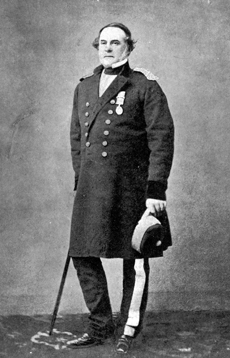
By the 1850s, a growing expansionist movement in Canada saw the annexation and settlement of the Northwest as essential to Canada’s development and prosperity. Expansionists portrayed the HBC as an impediment to Canada’s growth and claimed that, to protect its fur trade interests, the HBC had promoted the widely held belief that the Northwest was a barren wasteland, unsuited to agricultural settlement. This belief, however, was challenged by reports of the Palliser and Hind expeditions, which encouraged westward European settlement.
In 1863, the International Financial Society bought controlling interest in the HBC, signalling a shift in the company’s outlook: most of the new shareholders were less interested in the fur trade than in real estate speculation and economic development in the West. Negotiations conducted with the Colonial Office and, after 1867, with the Canadian government, eventually resulted in the sale of Rupert’s Land to Canada in 1870. As part of the agreement, the company received £300,000 and one-twentieth of the fertile areas to be opened for settlement. In addition, it retained title to the lands on which it had built trading establishments.
The terms of the agreement strongly influenced company development after 1870. By retaining large landholdings on the prairies and the parcels adjacent to its posts, many of which were located in developing urban centres in the West and North, the HBC was able to become one of the most important developers in western Canada. From the 1874 establishment of the Land Commissioner’s Office onward, the company was active as a major real estate developer, acquiring control of Markborough Properties in 1973 before eventually spinning it off as a stand-alone company in 1990.
Natural-Resource Development
Involvement in natural-resource development stemmed naturally out of the HBC’s fur trade and real estate activities. In 1926, it co-founded Hudson’s Bay Oil and Gas (HBOG); in 1973, it acquired 35 per cent of Siebens Oil and Gas. In 1979, it disposed of the latter and in 1980 bought controlling interest in Roxy Petroleum. In 1982, the HBOG investment was sold to Dome Petroleum (see Petroleum Exploration and Production).
Retail Expansion
As economic development in the Prairie West accelerated after 1870, the company did an increasing amount of business with settlers. Initially, most of this activity was carried on at its trading posts. Since it differed in many respects from the trade with Indigenous groups, separate sales shop accounts were kept. From this modest beginning, the HBC’s retail and wholesale divisions eventually emerged, with outlets entirely separate from the fur trade. In 1910, the company was restructured into three departments: lands sales, fur trade and retail. In 1913, the HBC invested in the construction of new retail stores, recognizing that this department had a greater future potential than land sales and the fur trade. The first of the company’s “original six” department stores was opened in Calgary that year. The last was opened in Winnipeg in 1926. In 1959, the fur trade department was renamed the northern stores department, while the land sales department was moved to a subsidiary company in 1961.

Previously operating entirely in western Canada, in 1960, HBC began expanding into central Canada with the acquisition of the Montreal-based Henry Morgan & Company department store chain. In 1970, the 300th year of HBC’s existence, Queen Elizabeth II granted a new charter to the company revoking most of the provisions of the original charter and formally transferring the company from the United Kingdom to Canada, where a new headquarters was established in Winnipeg, Manitoba.
The 1970s were a period of expansion with the acquisition of Shop-Rite and A. J. Freiman Ltd. (1972), as well as majority interests in companies like Markborough Properties (1973), which would support their retail growth. In 1974, HBC opened its first Toronto store at Yonge and Bloor, and moved its corporate offices to Toronto. In 1978, HBC acquired the Simpsons department store chain, established in 1872 by Robert Simpson, converting its locations to Bay stores in 1991.
HBC was the subject of a takeover battle in the late 1970s, when Canadian billionaire Kenneth Thomson and George Weston Limited fought for control, with Thomson eventually coming out ahead and acquiring a 75 per cent stake in a $400 million transaction in 1979.
HBC’s expansion continued in the 1990s. The company purchased the bankrupt Woodward’s department store chain in 1993 and K-Mart Canada’s stores in 1998, bringing them into the Zellers fold. HBC’s chain of Zellers stores operated in the mass merchandise category and aimed to provide convenient access to everyday items at an affordable price. Beginning in 1994, Zellers faced fierce competition from its American rival Wal-Mart.
In 1997, the Thomson family sold the last of its remaining shares, but in the intervening years they had transformed HBC to a leaner, more focused operation by selling off the company’s interests in the oil and gas business, financial services and a distillery, among others, for approximately $550 million.
In 1999, HBC opened the Home Outfitters chain of kitchen, bed and bath stores.
21st Century
While the company built its brand around the department store setting and selling over the counter, the 2000s brought a change in the retail landscape. Traditional ways of selling goods were challenged by online retailers. The company first offered an online shopping experience in 2000, a direct response to this evolving retail landscape.
Declining sales and competition from US retailers encouraged rumours regarding takeovers. Speculation ended when American financier Jerry Zucker acquired HBC for over C$1 billion in 2006. In 2008, the New York-based private equity firm and parent company of Lord & Taylor, NRDC Equity Partners, bought HBC from Zucker’s widow. Under the direction of the company’s first woman CEO, Bonnie Brooks, HBC’s new parent company initiated a rebranding project that sought to make it competitive with other mid-market and high-end department stores. Initiatives included offering shoppers more external brands, product selection as well as contemporary branding.
Zellers
In 2011, the company's Zellers chain announced a plan for closure and liquidation that facilitated Target Corporation’s short-lived entry into Canada. Zellers closed most of its locations by 2013. In 2023, HBC announced that 25 Zellers stores would open in Hudson’s Bay locations across Canada. In addition to the new store locations, a Zellers e-commerce website would be launched.
Saks, Inc.
In 2013, HBC acquired American luxury retailer Saks, Inc., operator of Saks Fifth Avenue and the Saks OFF 5TH franchise, for US$2.9 billion.
Galeria Kaufhof
In 2015, HBC acquired German department store chain Galeria Kaufhof for $3.3 billion in a deal that also included Belgian retail chain Galeria INNO. The purchase included some 135 stores in Europe. HBC acquired online retailer Gilt.com in 2016, only to sell it two years later amid poor performance in HBC’s off-price divisions. By 2019, the company owned over 400 stores but had reported losses three years in a row. Before the end of the year, HBC sold Lord & Taylor and its European chains, and it announced the closure of all 37 Home Outfitters stores.
HBC went public on the Toronto Stock Exchange in 2012, but a group of shareholders took HBC private again in 2020, de-listing it from the Toronto Stock Exchange. Under CEO Richard Baker, HBC restructured, becoming wholly owned by a Bermuda-based holding company. The Hudson’s Bay Company’s current operations include Hudson’s Bay, Saks Fifth Avenue and Saks OFF 5TH in Canada and the United States. HBC operates nearly 239 stores and employs about 22,000 people internationally. The 85 Hudson’s Bay stores in Canada are the traditional and best-known face of HBC. They offer a full range of goods and services typically associated with department stores and feature proprietary brands. The company also has investments in real-estate joint ventures.
Branding and Logos
Beginning in 1965, the department store embraced the short form of its name, “The Bay,” and its logo featured a prominent B. In 2013, HBC’s logo underwent a significant overhaul, using a wordmark from the HBC red ensign. The new logo and the department store’s return to the fuller mantle of “Hudson’s Bay” was an effort to acknowledge the company’s rich heritage and role in Canadian history (see also Business History). This is also exemplified by HBC’s use of its historic coat of arms bearing its traditional motto, pro pelle cutem (“a pelt for a skin”). The rebranding also included the launch of the Hudson’s Bay Company Collection, a line of merchandise featuring the colourful stripes of the company’s iconic point blanket. The motif has adorned everything from dog apparel to housewares and canoes.

Olympic Outfitter
In 2005, the company began its partnership with the Canadian Olympic Committee (COC) and was named the Official Department Store and General Merchandise Store Operator in Canada. HBC, taking over from Roots Canada, outfitted the Canadian Olympic team with iconic toques and mittens. The most popular iteration of these products was produced for the 2010 Olympic Winter Games in Vancouver, which the chairperson of the London 2012 Olympic Summer Games, Sebastian Coe, called the “must-have item” of the games. This partnership was renewed in 2011 for a term ending in 2020.
Community Work
As Canada’s oldest company, HBC is part of the country’s business and social fabric and, as such, is involved in the community in a number of ways.
In 2004, the company created the HBC Foundation to represent its charitable efforts, which have included the Zellers charity gift box program, cystic fibrosis and the Canadian Cancer Society. In 2017, the HBC Foundation launched in the United States and announced that its charitable work would focus on mental health programs in both countries.
The HBC History Foundation is active in sharing the company’s long and rich history with the Canadian public. It provides financial support to the HBC Archives, the HBC Corporate Artifact Collection and Canada’s National History Society. It also supports history projects across Canada.

 Share on Facebook
Share on Facebook Share on X
Share on X Share by Email
Share by Email Share on Google Classroom
Share on Google Classroom






